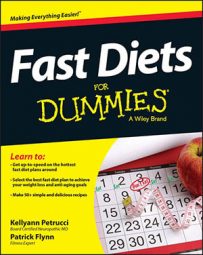One of the perks of the 5:2 Diet is that you aren't dieting most of the time, and the research has shown that this type of fasting style is as effective in weight loss as long-term calorie restriction.
Unlike fasting on occasion, daily calorie restriction over the long term typically leaves its followers feeling deprived. As a result, they commonly fall off the wagon and don’t get back on again until they come across another fad diet that promises quick fat loss.
With the 5:2 Diet, you eat as you normally eat five days a week. Twice a week, you greatly restrict your calories to just 500 (for women) or 600 calories (for men).
For example, say you ate your last meal at 8 p.m. on Sunday. The following morning you eat a small breakfast (really nothing more than a healthy snack), and then you have another small meal sometime that evening. When you wake up Tuesday morning, it's back to business as usual. You return to your regular eating patterns, not to fast again until your second fast day that week.
For the calories that you do eat while on your modified fasting days, choose ones that won't raise your blood sugar too much. The reason for this is twofold:
Fasting can give your body a rest from having to pump out insulin and thus raising your blood sugar levels.
Any food you eat will have an effect on your blood sugar, so if you spike it too much too quickly, you'll experience the dreaded blood sugar crash and may not be able to complete a successful fast.
Because of variations in body weight, hormones, and other factors, women and men have different caloric limits on the 5:2 Diet fast days. Women are limited to 500 calories, whereas men are limited to 600 calories.
The 5:2 Diet, like other fasting methods, can help do the following:
Activation of the body's repair genes: When fasting, a process in the body, called autophagy, gets switched on. Autophagy means to self eat, so in this repair process the body begins to break down and dispose of old, tired cells, making way for new, healthy ones.
Better moods: The 5:2 Diet can increase the production of a protein called brain-derived neurotrophic factor (BDNF). Studies have shown that increased levels of BDNF can positively affect the brain, and therefore mood, in much the way that sustained antidepressant medication can.
Increased insulin sensitivity: The 5:2 Diet helps the body use insulin more effectively, meaning that you don't need to produce as much insulin to get the same amount of work done. By using insulin more effectively, you place less stress on your pancreas, as well as head off the negative effects that too much insulin can cause, such as accelerating the aging process.
Reduction of insulin-like growth factor (IGF-1) levels: IGF-1 is a hormone that humans produce. The variances in levels present in children help determine growth and future height. However, over time, it's beneficial for adults to have lower levels of IGF-1 because higher levels later in life are correlated with an increased risk of cancer, as well as premature aging.
Fasting periodically seems to decrease IGF-1 levels in adults, potentially reducing the likelihood of developing common diseases that are associated with age, such as diabetes and cancer. Thus, although it doesn't guarantee immortality, fasting on occasion may give you a taste of the Fountain of Youth.
Weight loss: The 5:2 Diet includes a decrease in body fat percentage and an increase in lean muscle mass.

